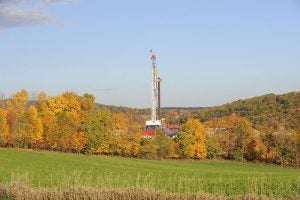Fayetteville flyover study sheds valuable light on the role of regional episodic emissions
 Five years ago, EDF initiated a series of 16 peer-reviewed scientific studies involving over 100 research and industry experts in order to better quantify the methane emissions coming from the U.S. oil and gas industry and to better understand where and how to focus efforts to reduce them. Since then, over 30 peer-reviewed papers have been published across a number of scientific journals, with the data indicating that emissions from the industry are generally higher than official U.S. estimates.
Five years ago, EDF initiated a series of 16 peer-reviewed scientific studies involving over 100 research and industry experts in order to better quantify the methane emissions coming from the U.S. oil and gas industry and to better understand where and how to focus efforts to reduce them. Since then, over 30 peer-reviewed papers have been published across a number of scientific journals, with the data indicating that emissions from the industry are generally higher than official U.S. estimates.
However, quantifying methane wasn’t our only goal. We also sought to catalyze a community of researchers — both inside and outside academia — to continue this work, because there is still much more we can learn about how to effectively reduce this powerful climate pollutant. So I was pleased to see the publication of a new independent study that evaluates methane emissions from natural gas infrastructure in the Fayetteville Shale region of Arkansas.
Researchers estimated regional emissions based on data collected during two flights in October 2015, and teamed up with the major operators in the area to help interpret the results. This proactive industry involvement is valuable for increasing our understanding about what factors may cause excessive emissions.
For this study, companies provided very detailed information about a routine operation known as manual liquids unloading – the process of unclogging a well of liquids that inhibit gas production. Specifically, industry provided the research team with the start and end times of 107 manual liquids unloading events taking place during the two midday flight windows. Thanks to these insights, researchers estimate that 30-50% of the emissions measured during the regional flights were due to these episodic events. The authors of this study report that emissions from manual liquids unloadings in the Fayetteville Shale are not equally spread across all hours of the day; instead they occur preferentially during working hours. Consequently, emissions from these episodic events measured around midday may be 3-5 times higher than the daily average.
Putting the data to use
Traditionally top-down studies like this one — which use aircraft to capture methane data in the atmosphere—find higher methane levels than studies that rely on ground-based measurements. My science colleagues also tell me that the aircraft-based methods used in this paper reduce uncertainty between top-down and bottom up studies by carefully accounting for the background methane entering the study area which varied from East to West (although they were unsure about the effect of excluding 13 of 15 flights – deemed unsuitable for analysis – on the study’s conclusions).
These results can be expected to vary from basin-to-basin. Planned, episodic events may account for a significant portion of emissions in the Fayetteville, but research in other basins finds that abnormal, unintended events are the defining attribute of super-emitting sites – random, unpredictable sites responsible for a disproportionate amount of methane emissions. We suspect both play a role in explaining the difference in emissions data from “top down” and “bottom up” studies reported in other basins.
The good news is unloading liquids is a common, planned event at a certain time of day – meaning companies can target interventions that are timely, efficient, and effective at reducing emissions. Now that the study has surfaced a principal cause of methane emissions in this region, a key next step is to implement suitable emission reduction strategies through company practice and federal and state regulation.
Image source: Wikimedia











